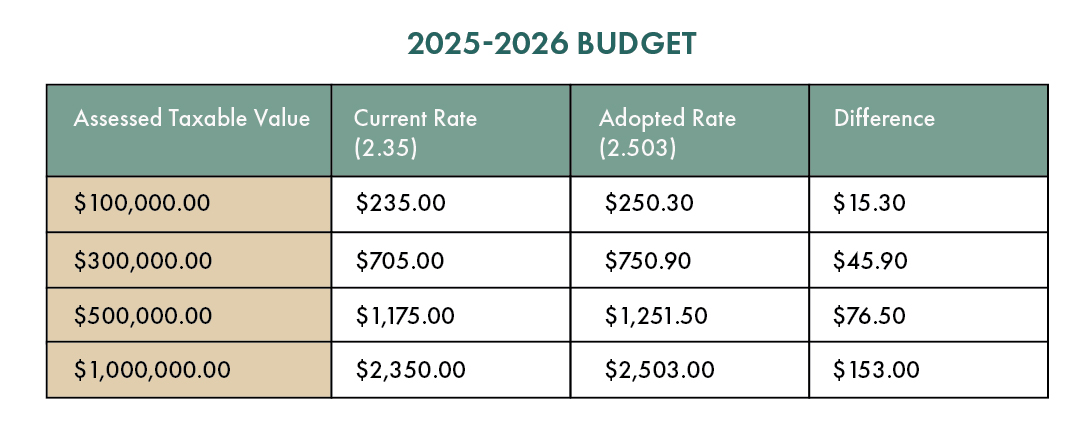2025-2026 Budget FAQ
Published on September 18, 2025

Budget FAQ | Final Adopted Millage Rate: 2.503
Why did the Village Council increase the millage rate?
The Council faced the tough choice of either raising the millage rate slightly or cutting essential services. Inflation, unfunded state mandates, and reduced federal support have all driven up costs for everything from police equipment to storm preparedness. Pinecrest relies almost entirely on residential property taxes, since the Village has very little commercial or industrial tax base.
By adopting a millage rate of 2.503 for the fiscal year October 1, 2025, through September 30, 2026, the Village is:
- Preserving police protection with competitive salaries and updated equipment.
- Protecting the $5 million disaster reserve that keeps services running after storms while federal aid is delayed.
- Continuing infrastructure improvements like road resurfacing and drainage.
- Maintaining parks, schools, and community programs without cutbacks.
What is a millage rate?
A millage rate is the amount you pay in taxes for every $1,000 of your property’s taxable value (after exemptions such as Homestead). At 2.503 mills, the Village tax is $2.503 for every $1,000 of taxable value.
Does this cover my entire property tax bill?
No. Pinecrest’s millage is only one part of your bill. Miami-Dade County, the School Board, and other taxing authorities each set their own millage rates separately.
Why does my Notice of Proposed Taxes (TRIM Notice) from the County say that my Pinecrest municipal tax mill rate is 3.86?
Florida law requires cities to set a proposed maximum millage rate each July. This “cap” appears on your TRIM Notice, but it is not the final rate.
- Earlier this summer, Pinecrest set 3.86 mills as that ceiling to allow flexibility during the budget process.
-This was never intended to be the final rate. After workshops and public hearings, the Council adopted the lower final rate of 2.503.
How does this affect me personally? At 2.503 mills, a homeowner pays about $15 more for every $100,000 in taxable value.
Examples:
- If your taxable value is $300,000, the increase would be about $45.90 per year.
- If your taxable value is $500,000, the increase would be about $76.50 per year.
- If your taxable value is $1,000,000 the increase would be about $153 per year.

What's would have happened if the millage rate hadn't been adjusted?
Without this adjustment, the Village would have been forced to cut or delay services. That could have meant:
- Fewer police officers or reduced patrols.
- Deferring road resurfacing and drainage projects.
- Cutting back on park maintenance and school support.
- Weakening storm reserves needed to respond after hurricanes.
What does the FY 2025-26 budget fund?
The adopted $41.1 million operating and capital budget covers the services and projects that keep Pinecrest safe, well-maintained, and resilient.
Core Operations
- Police Department salaries, benefits, and major equipment upgrades.
- Technology and cybersecurity upgrades.
- Day-to-day operations for parks, public works, and general government.
- Continued school support grants, funded since incorporation.
Capital Projects
- Police fleet replacements ($428,883)
- Police taser replacement ($29,500)
- Police computer hardware replacement ($35,250)
- Ludlam Road resurfacing ($779,300)
- Pinecrest Gardens Horticulture Master Plan ($128,620)
- Municipal Center elevator modernization ($245,250)
- InTouch DX Time Clocks upgrade ($44,770)
- Public Works pressure washer ($20,000)
Reserves
- $5 million emergency reserve for storm recovery and federal aid delays
- General fund reserve consistent with Village financial policy and state guidelines
- Carryover funding for $7 million in awarded stormwater drainage projects
Why does Pinecrest rely so heavily on property taxes?
Pinecrest is mostly single-family homes with limited commercial businesses and no industrial properties or tourism revenue. That means property taxes fund nearly everything, from police and roads to parks and drainage systems. This narrow funding base makes the Village vulnerable when costs rise or the state cuts our revenue options - and both are happening right now. Inflation is hitting every part of the Village’s budget labor costs, construction materials, insurance, and utilities. Everything costs more than it did even two years ago. Our police department needs competitive salaries to retain good officers, plus major equipment and technology upgrades to keep you safe. The state now requires expensive cybersecurity measures that we must fund. Meanwhile, voter-approved changes starting in 2025 will reduce our property tax revenue even as costs keep climbing.Additionally, the state legislature is considering even more cuts to local government funding.
How are disaster reserves protected?
Pinecrest maintains a $5 million emergency reserve to cover storm recovery costs and delays in federal reimbursements. These funds allow the Village to:
- Pay overtime for police and public works crews
- Cover fuel and generator costs
- Remove debris and reopen roads quickly
- Maintain services while waiting for federal aid
Without adequate reserves, we'd either have to cut services when residents need them most or take on expensive emergency loans.
The $5 million emergency reserve is essential for keeping services running when outside help is delayed.
Is the playground at Veterans Wayside Park part of the 2025–26 budget or tied to the millage increase?
No. Funding for the Veterans Wayside Park playground was already approved in the FY 2024 budget and is not connected to the millage rate increase adopted this year. The $374,946.35 cost is fully covered by the remaining balance in the previously allocated Veterans Wayside Park capital project fund.
The project came directly from resident input and the Village’s Parks Master Plan, which identified a need for more walkable, neighborhood-scale playgrounds. The playground will be set back inside the park and buffered from US-1 with fencing and landscaping to ensure safety.
Where can I view the FY 2025-26 Adopted Budget?
You can view the full FY 2025–26 Adopted Budget on the Village website.